Vegetation Analysis: A Tool for Restoration of Degraded Habitats of Raikela Iron Ore Mines
RK Mishra*1 and BK Patra2
1Department of Wildlife and Biodiversity Conservation, North Orissa University, Baripada-757 003 India
2Centre for Envotech and Management Consultancy Pvt Ltd, N-5/305, IRC Village, Nayapalli, Bhubaneswar-751015, India
Submission: September 28, 2017; Published: October 12, 2017
*Corresponding author: RK Mishra, Department of Wildlife and Biodiversity Conservation, North Orissa University, Baripada-757 003, India, Email: rabikumishra@gmail.com
How to cite this article: RK Mishra, BK Patra.Vegetation Analysis: A Tool for Restoration of Degraded Habitats of Raikela Iron Ore Mines. Int J Environ Sci Nat Res. 2017;5(5): 555674. DOI:10.19080/IJESNR.2017.05.555674
Abstract
The study was carried out with an aim to select indigenous plant species for restoration of a degraded habitat at Bonai reserve forest area formed due to mining in Sundergarh district of Odisha. Species for restoration were selected from mine forest area through systematic phytosociological analysis that involved measurement of Importance Value Index (IVI) and regeneration values of tree species. However, species selection from plantation was made based on their growth, productivity, and adaptation to terrain and soil types. Shrubs and grasses were selected based on relative index and relative abundance, respectively. The top 15 tree and 16 grass species, and the entire six shrub species were selected from mine forest area and plantation were considered for restoration of dump areas. Since soils of dump were of similar nature as that of the forest area, the findings will be helpful in faster restoration of the degraded habitats with initial human facilitation. After care and monitoring has also been suggested to enhance the recovery process.
Keywords: Adaptation; Degraded; Growth; Importance Value Index (IVI); Productivity; Restoration; Vegetation
Abbreviations: IVI: Importance Value Index; RF: Relative Frequency; RIOM: Raikela Iron Ore Mine; RF: Relative Frequency; RDo: Relative Dominance; RI: Relative Index
Introduction
Ecological restoration aims to recreate, initiate, or accelerate the recovery of habitats that has been disturbed. Disturbances are environmental changes that alter ecosystem structure and function. Common disturbances include mining, logging, damming rivers, intense grazing and fire. Out of these disturbances degradation of natural habitats due to opencast mining leads towards clearing of vegetation is a common phenomenon. Normal recovery of distributed habitats takes times through colonization of plant and animal species [1-3] and can be accelerated through human intervention. Till yet, not much attention was paid to restore these habitats. Recent awareness followed by stringent enforcement of rules and regulations has generated consciousness about the environment. Restoration has been attempted on an experimental basis in various parts of India [4-7] through implementation of plantation programme. In such practices plantation of exotic and horticultural species has attempted for restoration and as a result the degraded land has been made productive [8].
Restoration is the recreation of entire communities of organisms, closely modeled on those occurring naturally, while reclamation refers to any deliberate attempt to return a damaged ecosystem to some kind of productive use [9-11]. It would appear that in many cases, it is reclamation rather than restoration which is attempted. Restoration needs knowledge of indigenous biological resources for understanding the species response to micro-environmental features and edaphic conditions [12-14]. Information on these aspects not only helps in selecting species adapted to local conditions [7] but also in the fast recovery of the ecosystem when such species are planted there [15,16]. This article represents the outcome of a study that included these aspects to help in ecological restoration of a disturbed site at Bonai reserve forest area in Sundergarh district, Odisha.
The Bonai reserve forest in Sundergarh district, Odisha has been disturbed due to mining since 1970. The area with dry deciduous forests contains good quality of minable iron ore deposits. To undertake the mining activities some part of the forest covers of this reserve forest was cleared. Presently dumping is being done in well vegetated valleys adversely affected the vegetation. Thus the present study was an attempt to select plant species based on a set of criteria in restoring the degraded habitat of Raikela Iron Ore Mine, Odisha.
Study area
The Raikela Iron Ore Mine (RIOM) 210 52/ 45// to 210 53/ 08 //N latitude and 850 11/ 05 // to 850 11/ 30 // E longitude having a lease area of about 45.93 ha covers some part of Bonai reserve forest in Sundergarh district of Odisha. In this area mining has been done in 29.184 ha and 4.16 ha have been used as dump. The rate of extraction of ore is around 5, 02, 200 TPA. The ore to waste ratio is 1.8:1 which might decrease to 1:1 with increasing depth. The mines lease area includes the following:
i. Forest area (FA): 12.592 ha, where mining activities have not yet been taken up and have natural vegetation in some parts.
ii. Active dump (AD): Nearly equal to one hectare area i.e. 0. 75 ha, where waste and top soil of the mining area is being dumped.
iii. Old dump (OD): 3.41 ha, where the waste and top soil was dumped in the past. Only Acacia farnesiana has been planted here.
iv. Mining Area (MA): 29.18 ha, where mining has been done.
The soil of the area is slightly acidic (pH: 5.8 ± 1.18), loamy with some proportions of silt and clay. The depth varies from shallow (0-30cm) and medium (31-50cm) to moderately deep (51-80cm). Most areas have medium depth soil. More than 50% of the area has moderate to good water holding capacity. Average value of some important soil physico-chemical characters of the study area is presented in (Table 1).
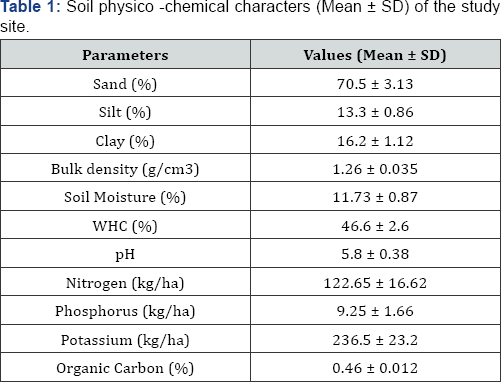
Source: EIA and EMP Report [17]; WHC: Water Holding Capacity.
Methods
A reconnaissance survey was carried out from June, 2010- May, 2011 in FA, OD, AD and plantation (P). FA was studied in twenty stratified random belt transects, each 25x20m. The stratification was based on the habitats and major topographic variation. In each transect, data on trees ( > 30cm gbh) such as girth at breast height (137cm above ground), height, canopy height, canopy width and regeneration (plants <10cm gbh) were recorded. Shrub species and their frequency were recorded on these transects, while in case of herbaceous species, abundance was recorded. OD and AD had only herb cover that was estimated at 10m intervals along five lines transects in each of them. Since herb cover on AD and OD was low, it was estimated quantitatively i. e. rare, common and abundant, and an abundance rating (AR) was given to each herbaceous species. The rare species was rated as 1, while the common and abundant species were given a score of 2 and 3, respectively.
Species selection from forest
Tree species for restoration were selected in two phases. In the first phase, the top 15 species were selected based on Importance Value Index (IVI). Remarking was given to each species based on the IVI. IVI was calculated as a sum of relative density (RD), relative frequency (RF), and relative dominance (RDo) [17,18]. During the second phase of selection, regeneration potential was included. Tree species represented by more than 15 individuals in the regeneration stage was ranked 1, and species having no regeneration were ranked 3. Adding IVI and regeneration ranks, the top ten tree species were selected for restoration. Shrub species were selected using relative index (RI) computed as a sum of RD and RF [8]. For herbaceous species only abundance was calculated as per Kershaw [19].
Species selection from plantation
Tree species in "P" were selected based on their growth, productivity and adaptation. The growth was estimated using Size Index [8] as:
SI=Tree height (cm) x gbh (cm)].
Productivity potential of tree species was estimated using Canopy Index [8] as:
CI=Average canopy height + Average canopy width) x no. of sample trees.
Adaptation potential of species was evaluated as; species grown on the slopes were ranked 1, species grown on flat terrain were ranked 2, while those species grown in valleys, stream bed or river bed were ranked 3 and 4, respectively. The species growing on shallow soils were ranked 1, while those on medium and deep soil were ranked 2 and 3, respectively. Adding the ranks for growth, productivity, terrain and soil, the top ten species were selected. Some species were included based on their properties to enrich the soil.
Results and Discussion
Species richness and abundance
A total of 58 species were recorded in FA and includes 30 trees, 6 shrubs and 22 herbaceous species (Table 2). However, in plantation only12 tree species were recorded. Tree species enumerated in FA were nearly equal to 1.5 times more than in "P". Seven tree species were common to both FA and "P". Of these, Gmelina arborea, Diospyros melanoxylon and Albizia lebbeck performed better in "P" only. On the other hand Xylia xylocarpa performed well in both. In shrubs their diversity was low with respect to number of species as compared to trees and herbaceous species. Only six shrub species were recorded in the study area. However, 22 numbers of herbaceous species were recorded and their diversity in terms of number of species was intermediate between tree and shrub species enumerated from the study area (Table 3).
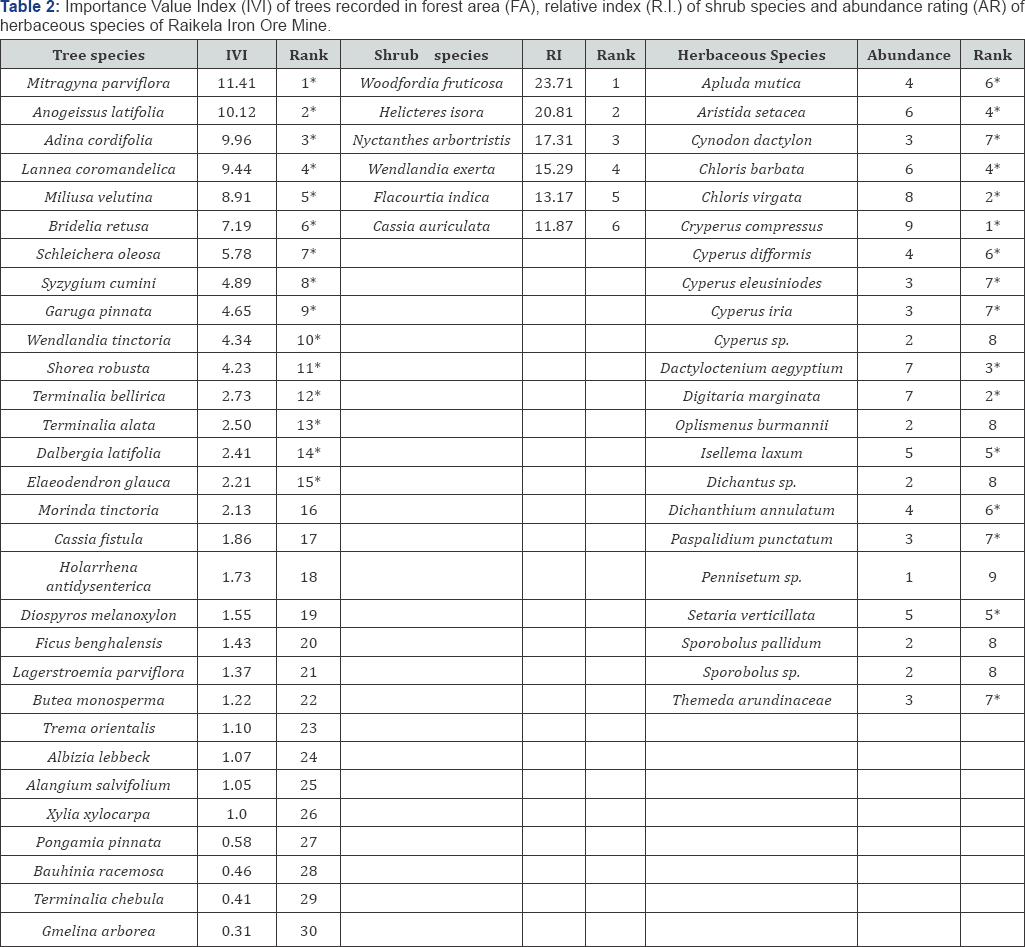
* Species selected for restoration.
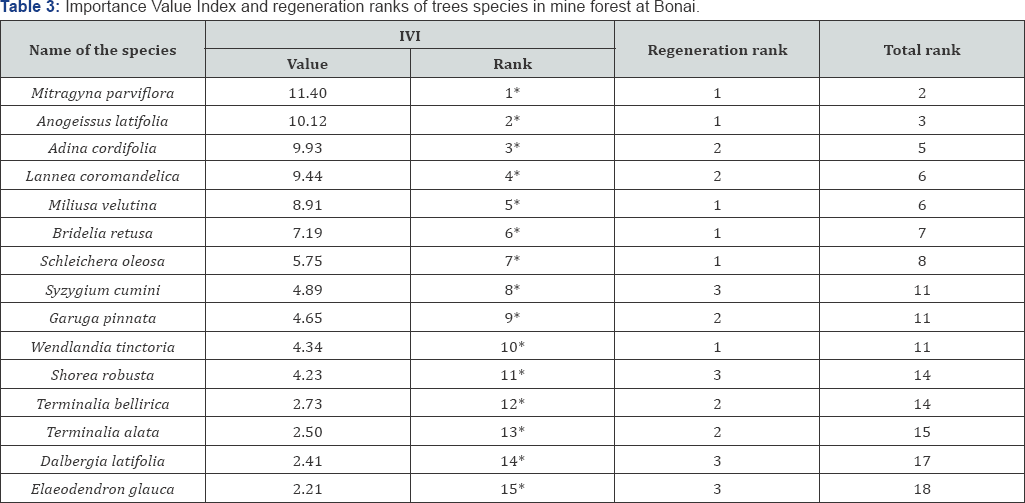
Plant species diversity at tree level was more in FA then "P" This is natural because plantations are generally monocultures or at best include few species of interest and are single layered. Forests, on the other hand, grow with natural succession have stratification resulting in higher species diversity of not only plants but also animals [20]. In plantation instead of IVI, growth rate and productivity of tree species was considered along with terrain and soil depth for species selection. The age of tree species (years after plantation) ranged from 4 to 6 years. G. arborea was the fast-growing species with maximum growth rate of 3842 cm2/year while Xylia xylocarpa gained maximum productivity of 46 cm2/year (Table 4).
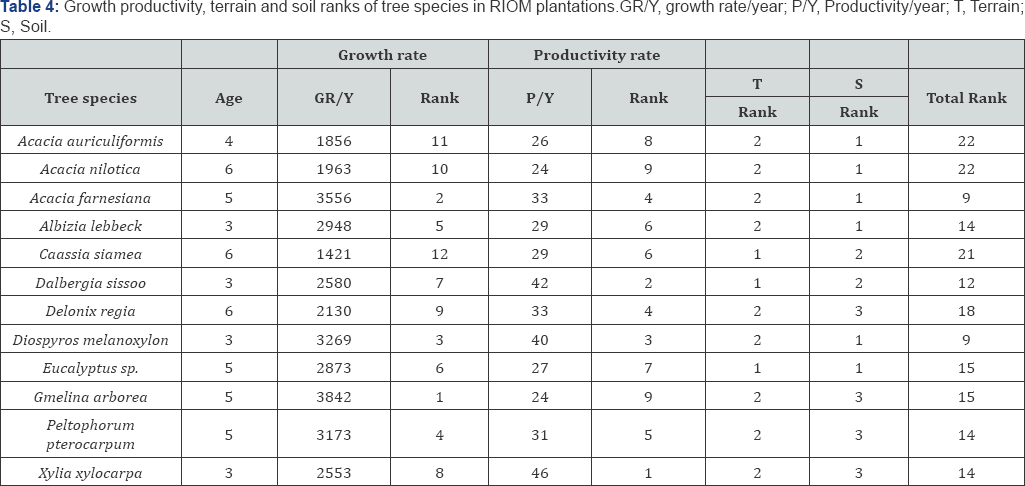
When adaptation to terrain and soil depth was included in the selection parameter, A. farnesiana and D. melanoxylon shared the top rank. Parameters used for selection of species were decided in order to measure their adaptation and robustness to grow in difficult conditions. Inclusion of more than one parameter ensure that even if some species scored equal points on one parameter, the difference in scores in other parameters helped in selecting the better species. For example, tree species in plantation showed similarity in productivity but there was a variation in growth rate. In addition to selection of parameters, selection of species for plantation from different sampling areas (FA, OD, AD, and P) helped in developing a comprehensive list of species based on their performance in diverse habitats. Only 12 tree species were grown in plantation, out of which 7 species did occur in FA. On the other hand, a relatively large number species in the FA helped in providing more options for the species selection. The cumulative list of 20 tree species, 10 each from FA and plantation provided best performing local species in the vicinity, to boost natural colonization (Table 5).
Further, the study envisages that to increase the fertility level of dump, growing leguminous plant would be more useful, as they supply nitrogen to the root zone in mine spoil [13]. Acacia sp. and A. lebbeck are some of the species that have high nitrogenous activity in root nodules [21,22]. Therefore, these tree species are suggested to grow on dumps as well as in the degraded areas. In addition to these Pongamia pinnata is considered as one of the promising species for overburden of mining areas [23] and should be planted on the dumps to enrich soil. The findings also suggest that tree species selected from 'P 'may perform well when planted on dumps as indicated by better growth of G. arborea, D. Melanoxylon, P. pterocarpum and A. lebbeck. The list of tree species suggested for plantation is given in (Table 5).
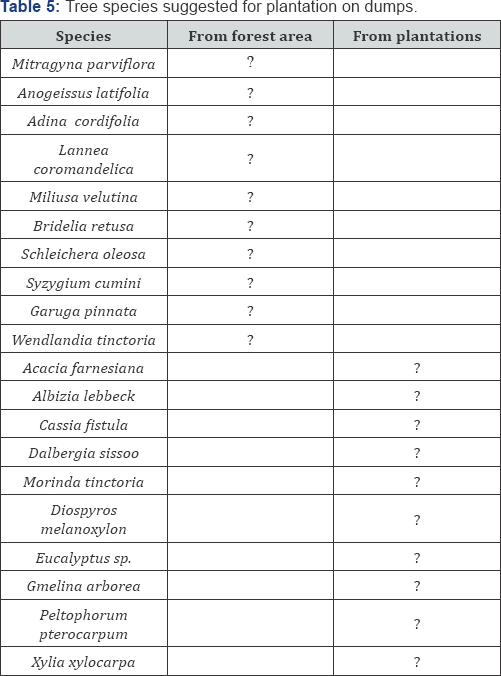
Shrub and herbaceous species selection
The RI of shrub species in the FA ranged from 11.87 to 23.71. Woodfordia fruticosa had maximum RI followed by Helicteres isora and Nyctanthes arbor-tristis, while Cassia auriculata had the minimum RI (Table 2). All the six species found were recommended for use in restoration activity. Abundance of herbaceous species in the FA ranged from 1-9. Maximum abundance was experienced by Cyperus compressus followed by Chloris virgata, Dactyloctenium aegypticum = Digitaria marginata, Chlorisbarbata = Aristidasetacea, Setaria verticillata= Isellema taxum, etc. However, the minimum was experienced by Pennisetum sp. (Table 2). On the basis of abundance rating the top sixteen herbaceous species were selected from the mining forest area for restoration activity (Table 2). Generally natural succession commences with herbaceous species among the higher plant groups.
Thus introducing the herbaceous species from the FA can enhance succession rate on OD and AD. Promoting selected native shrub and herb species on the periphery of dumps and on stream-bed can act as vegetative filter to reduce soil and water pollution in the surrounding areas as observed by [6,24]. Shrubs are more effective in halting runoff and erosion [25] than the agro forestry crops. Therefore, in this study, native shrub species are suggested for the dumps as the first phase of restoration. One of the parameters considered to select plant species was the slope gradient. Two shrubs named as N. arbor-tristis and W exerta and three herbaceous species named as S. verticillata, Themeda arundinaceae and D. aegyptium were found abundant on the slopes. Therefore, these species should be grown on dump slopes. The soils of both AD and OD were of similar nature as that of FA and P. Moreover 70cm of the topsoil is stocked separately for spreading it on the dumps during resolution. Therefore, the selected plant species will successively grow on dumps. A small part of OD has already been successfully planted with A. farnesiana.
Conclusion
To restore the biological quality of the degraded habitats of Raikela Iron Ore Mine (RIOM), selection of native plant life forms of different strata from FA and P based on the study of their IVI, regeneration potential, growth rate, productivity, relative index and abundance rank for plantation may be an ideal method. In achieving better growth of planted species on dumps certain steps should be followed which includes water management to promote growth of perennial species, protection from anthropogenic disturbances i.e. grazing and cutting. In addition, ecological study at regular intervals is needed to monitor the survival and growth of plant species and to find out the effects of various plant species on the habitat conditions. At regular intervals study on soil physico- chemical parameters indicate about the change in soil nutrient status of the restored area. Further, monitoring of vertebrate faunal communities and their association with plant life forms in restored areas may also be important in understanding the overall effects of restoration work. Such restoration practice is also important to reduce high rates of forest destruction, energy shortages and steps towards conservation of biological resources.
Acknowledgement
We thank Director, Raikela Iron Ore Mines (RIOM), Sundergarh for providing permission to conduct this study. Centre for Envotech and Management Consultancy Pvt. Ltd. is thankful for providing all necessary support for completing the study successfully.
References
- Pandey DN (2002) Sustainability science for mine- spoil restoration.Current Science 83: 792-793.
- Cole RJ, Holl KD, Zahawi RA (2010) Seed rain under tree islandsplanted to restore degraded lands in a tropical agricultural landscape.Ecological Applications 20: 1255-1269.
- Vibhash R, Sen P, Kumar D, Sarsawat A (2015) A review on dump slope stabilization by revegetation with reference to indigenous plant. Ecological Processes 4: 1-14.
- Jha, AK Singh, A Singh, AN Singh JS (2000) Evolution of direct seeding of tree species as a means of re-vegetation of coal mine spoils. Indian Forester 126 (11): 1217-1221.
- Dongmei LEI , Changqun D (2008) Restoration potential of pioneer plants growing on land-zinc mine tailings in Lanping, south-west China. Journal of Environmental science 20(10): 1202-1209.
- Sharma SD, Soni P, Chandra V (1998) Amelioration of the overburden of iron ore mine for free establishment. Annals of forestry 6(2): 239244.
- Singh AN, Raghubanshi AS, Singh JS (2002) Plantation as a tool for mine spoil restoration. Current Science 82: 1436-1441.
- Sharma D, Sunderraj SFW (2005) Species selection for improving disturbed habitats in western India. Current Science 88(3): 462-467.
- Parrotta JA, Knowles OH (1999) Restoration of tropical moist forests on bauxite mined lands in the Brazilian Amazon. Restoration Ecology 7: 103-116.
- Kumar SS, Sharma BK, Gough LP (1998) Richness, diversity and evenness of vegetation upon rehabilitation of gypsum mine spoiled lands in the Indian arid zone. Annals of Arid Zone 37: 139-145.
- Jim CY (2001) Ecological and landscape rehabilitation of a quarry site in Hong Kong. Restoration Ecology 9: 85-94.
- Rao AV, Tak R (2002) Growth of different tree species and their nutrient uptake in limestone mine spoil as influenced by arbuscular mycorrhizal (AM) fungi in India arid zone. Journal of Arid Environments 51: 113119.
- Singh AN, Raghubanshi AS, Singh JS (2004) Impact of native tree plantations on mine spoil in a dry tropical environment. Forest Ecology and Management 187: 49-60.
- Wong M H (2003) Ecological restoration of mine degraded soils, with emphasis on metal contaminated soils. Chemosphere 50: 775-780.
- Boyd E (2002) The paradox of the CDM and sustainable development. International Forestry Review 4(1): 77-80.
- Verma P, Verma RK (2017) Species diversity of arbuscular mycorrhizal (AM) fungi in Dalli-Rajhara Iron Mine overburden dump of Chhattisgarh (Central India). International Journal of Current Microbiology and Applied Sciences 6(4): 2766-2781.
- CEMC (Centre for Envotech and Management Consultancy) (2010) Environmental Impact Assessment and Management Plan of Raikela Iron Ore Mines, Sundergarh, Orissa, pp. 156.
- Curtis JT, McIntosh RP (1950). The interrelations of certain analytic and synthetic phytosociological characters. Ecology 31: 434-455.
- Kershaw KA (1973) Quantitative and Dyamic Plant Ecology. Edward Arnold Ltd, (2nd Edn), London, UK.
- Sayer J, Chokkalingam U, Poulsen J (2004) The restoration of forest biodiversity and ecological value. Forest Ecological and Management 20: 3-14.
- Sharma KD, Kumar S, Gough L (2000) Rehabilitation of lands mined for limestone in the Indian desert. Land Degradation and Development 11(6): 563-574.
- Mensah AN (2015) Role of re-vegetation in restoring fertility of degraded mine soils in Ghana: a review. International Journal of Biodiversity and Conservation 7(2): 57-80.
- Sekhar NU (2000) Decentralized natural resource management: From state to co-management in India. Journal of Environmental Planning and Management 43(1): 123-138.
- OP Chaubey, Jamaluddin, Ram Prakash R (2014) Bio-reclamation of degraded ecosystem. International Journal of Bio-Science and BioTechnology 6(4): 145-154.
- Sharma KD, Kumar P, Gough LP, Sanfilipo JR (2004) Rehabilitation of a lignite mine disturbed area in the Indian desert. Land Degradation and development 15 (2): 163- 176.






























